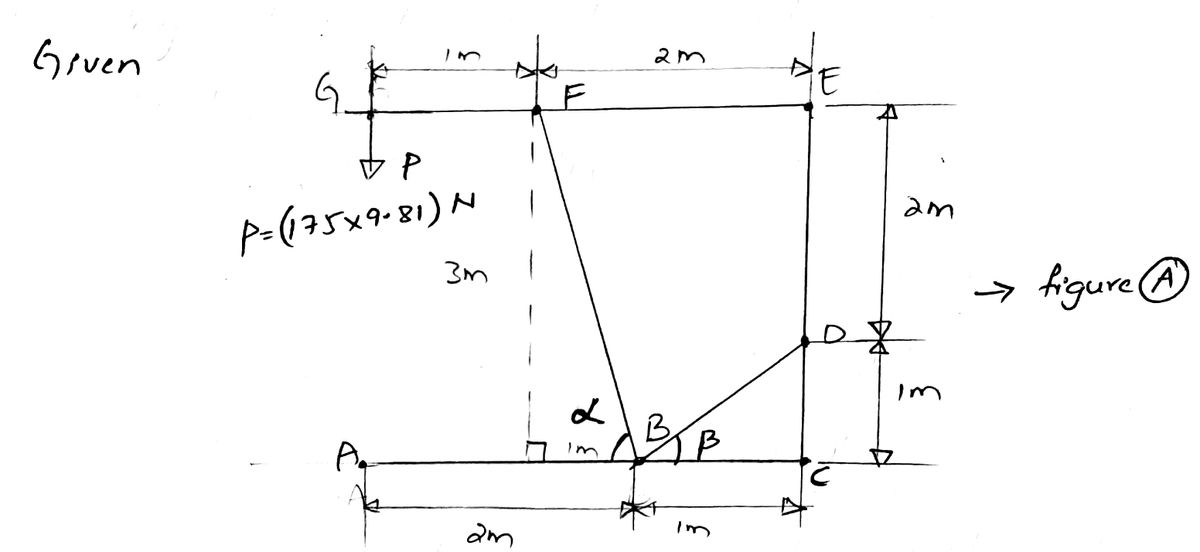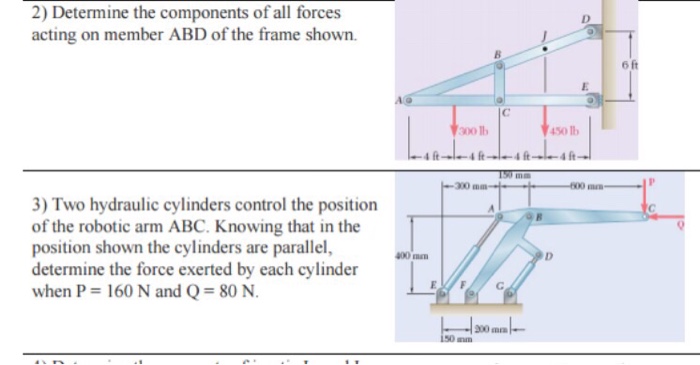Jan 07, 2018 The hydraulic cylinder BD exerts on member ABC a force P directed along line BD. The force P must have a 650-N component perpendicular to member ABC. Determine the magnitude of the force P. Members ACE and BCD are connected by a pin at C and by the link DE. For the loading shown, determine the force in link DE and the components of the force exerted at C on member BCD. SOLUTION:. Create a free-body diagram for the complete frame and solve for the support reactions. Define a free -body diagram for member BCD. The hydraulic cylinder BD exerts on member ABC a force P directed along line BD. Knowing that P must have a 750-N component perpendicular to member ABC, determine(a) The magnitude of the force P,(b) Its component parallel to ABC. Member B D exerts on member A B C a force P directed along line B D. Knowing that P must have a 300-1 b horizontal component, determine (a) the magnitude of t 🎉 The Study-to-Win Winning Ticket number.
- The Hydraulic Cylinder Bd Exerts On Member Abc A Force P Directed Along Line Bd
- The Hydraulic Cylinder Bd Exerts On Member Abc A Force P Directed
Jan 02, 2018 PROBLEM 2.29 The hydraulic cylinder BD exerts on member ABC a force P directed along line BD. Knowing that P must have a 750-N component SOLUTION perpendicular to member ABC, determine (a) the magnitude of the force P, (b) its component parallel to ABC.

1. Two forces P and Q are applied as shown at point A of a hook support. Knowing that P=75 N and Q = 125 N. Determine by trigonometry (a) the required magnitude of the force Q if the resultant R of the two forces applied at A is to be vertical, (b) the corresponding magnitude of R.
2, Solve by trigonometry. Two forces are applied at point B of beam AB. Determine graphically the magnitude and direction of their resultant using (a) the parallelogram law, (b) the triangle rule
3. The hydraulic cylinder BD exerts on member ABC a force P directer along line BD. Knowing that P must have a 750-N component perpendicular to member ABC, determine (a) the magnitude of the force P, (b) it's component parallel to ABC
4. Determine the resultant of the three forces. X and Y
© BrainMass Inc. brainmass.com October 1, 2020, 11:22 pm ad1c9bdddfhttps://brainmass.com/math/trigonometry/trigonometry-resultant-magnitude-269614
Attachments
Solution Preview
THese are problems from my textbook. The answers for these questions are in the back of the book but i'm unsure how to work towards those answers.
1. (a) 44.7 N (b) 107.1 N
2. 3.30 kN 66.6 degrees
3. (a) 2190 N. (b) 2060 N
4. 654 N 21.5 degrees
1. Two forces P and Q are applied as shown at point A of a hook support. Knowing that P=75 N and Q = 125 N. Determine by trigonometry (a) the required magnitude of the force Q if the resultant R of the two forces applied at A is to be vertical, (b) the corresponding magnitude of R.
.. Kasumi rebirth new.
The expert examines the two forces of trigonometry resultant magnitudes. A step by step solutions to all the problems are provided.
The hydraulic cylinder BD exerts on member ABC a force P directedalong line BD. Knowing that P must have a 750-N componentperpendicular to member ABC, determine (a) the magnitude of the forceP, (b) its component parallel to ABC?

1 Answer
The Hydraulic Cylinder Bd Exerts On Member Abc A Force P Directed Along Line Bd

(a) We need to find out #angle DBC#. From the figure

1. Two forces P and Q are applied as shown at point A of a hook support. Knowing that P=75 N and Q = 125 N. Determine by trigonometry (a) the required magnitude of the force Q if the resultant R of the two forces applied at A is to be vertical, (b) the corresponding magnitude of R.
2, Solve by trigonometry. Two forces are applied at point B of beam AB. Determine graphically the magnitude and direction of their resultant using (a) the parallelogram law, (b) the triangle rule
3. The hydraulic cylinder BD exerts on member ABC a force P directer along line BD. Knowing that P must have a 750-N component perpendicular to member ABC, determine (a) the magnitude of the force P, (b) it's component parallel to ABC
4. Determine the resultant of the three forces. X and Y
© BrainMass Inc. brainmass.com October 1, 2020, 11:22 pm ad1c9bdddfhttps://brainmass.com/math/trigonometry/trigonometry-resultant-magnitude-269614
Attachments
Solution Preview
THese are problems from my textbook. The answers for these questions are in the back of the book but i'm unsure how to work towards those answers.
1. (a) 44.7 N (b) 107.1 N
2. 3.30 kN 66.6 degrees
3. (a) 2190 N. (b) 2060 N
4. 654 N 21.5 degrees
1. Two forces P and Q are applied as shown at point A of a hook support. Knowing that P=75 N and Q = 125 N. Determine by trigonometry (a) the required magnitude of the force Q if the resultant R of the two forces applied at A is to be vertical, (b) the corresponding magnitude of R.
.. Kasumi rebirth new.
The expert examines the two forces of trigonometry resultant magnitudes. A step by step solutions to all the problems are provided.
The hydraulic cylinder BD exerts on member ABC a force P directedalong line BD. Knowing that P must have a 750-N componentperpendicular to member ABC, determine (a) the magnitude of the forceP, (b) its component parallel to ABC?
1 Answer
The Hydraulic Cylinder Bd Exerts On Member Abc A Force P Directed Along Line Bd
(a) We need to find out #angle DBC#. From the figure
- #angle BDC=90-50=40^@#
- #angle BCD=90+(90-60)=120^@#
- #angle DBC+angle BCD+angle CDB=180^@#
#=>angle DBC+120+40=180^@#
#=>angle DBC=20^@#Given
#P sin 20^@=750 N#
#=>P =750/sin 20^@ N#
#=>P =2193 N#
(b) Component of #P# which is parallel to #ABC#, #P_(||)#
#P_(||)=P cos20^@=2193xxcos20^@=2061 N#
